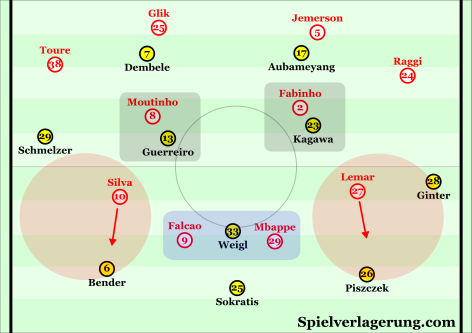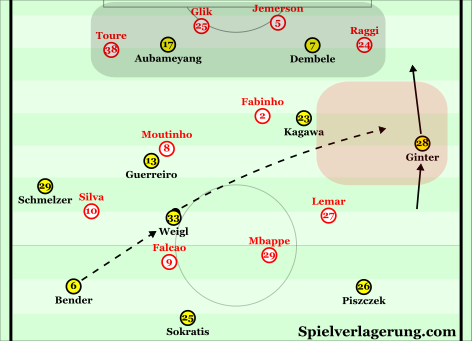Dortmund fall to Monaco despite Dominant Second Half
Borussia Dortmund hosted AS Monaco in the first tie of the Champions League quarter final. Whether or not they should have played (they absolutely shouldn’t have) would require a separate article, but what unfolded was an exciting and fast-paced match.
Tense Start
To begin the match, Monaco found some success in their pressure of Dortmund’s build-up. As ever, they pressed within their 4-2-2-2 which resulted in Mbappé and Falcao adopting positions close to Weigl. The two tens Lemar and Silva typically had high positions within the shape, which gave them access to both Piszczek and Bender respectively. With the two strikers having access to Weigl’s spaces, Moutinho and Fabinho could stay man-oriented to Guerreiro and Kagawa respectively.
Their front four access on Dortmund’s back three was effective in challenging the home side’s build-up from the first line. On cue with triggers such as a slow, horizontal or backwards pass, Monaco’s shape would shift to become asymmetrically a 4-3-3 with Silva higher and Lemar deeper. Doing so would enable Jardim’s side to effectively match-up three-on-three and increase their pressing outside of the block. In an attempt to ensure that Weigl did not receive passes in space between the lines, Falcao would try to keep him in his cover shadow. In higher cases, Fabinho could sometimes move up onto the former 1860 pivot.
Against this pressure, Dortmund struggled significantly. They were unable to progress from the first line and were restricted to harmlessly-slow horizontal circulation, which would inevitably move backwards – not forwards. They made more direct attempts due to their inability to progress with short passes, and sometimes used Ginter as a wide target against Lemar or Raggi, but to little success. As a result of their poor build-up, Monaco were encouraged more into their 4-3-3 shape, especially within the opening minutes.
In one or two cases, Sokratis made a forwards-dribble if Falcao and Mbappé conceded space to stay close to Weigl. Similarly, Piszczek was impressive in his half-back role and also used dribbles as a means of progressing the ball individually. He could sometimes receive the ball on the outside of Monaco’s first line with space ahead of him to move into. The best example of this was perhaps in the tenth minute, where he received the ball on a switch while Monaco were still regaining their shape. The Polish half-back was able to drive through the half-space, past Falcao, and played Aubameyang in behind Jemerson.
Given the reactivity of the two central midfielders – particularly Moutinho – I feel that Dortmund could’ve been more proactive in exploiting the structure of Monaco’s midfield. With Silva high, and Moutinho sticking close to Guerreiro, there were often cases where Monaco’s coverage of their right half-space was open. With Guerreiro commonly moving towards the touchline or dropping deeper, gaps were available yet Dembélé, who was acting as practically a second striker, was slow to drop inside.
Dortmund began to deal with Monaco’s press better after the opening moments, yet found themselves behind after a chaotic three minutes where they failed to manage the speed of the game. Their opponents had shown their danger during high-intensity games, and following Monaco’s missed penalty, Dortmund lost some stability which resulted in two dangerous attacks – the latter being the (albeit offside) opener. When Ginter made the cross into the box, the hosts’ counterpressing structure was extremely open, and had no coverage of Silva, an obvious threat in transition for carrying the ball at high speeds.
Ginter’s Defensive Role
For a wing-back in a five-man defensive line, Ginter’s role was quite unusual. The youngster followed Thomas Lemar far inside, as the attacking midfielder looked to engage in his team’s central possession as he always does. Considering that Monaco’s other player on this side was Raggi and not Mendy, this matter might not have been too problematic. It minimised Dortmund’s coverage of the right flank space but Raggi, who is Monaco’s back-up centre-back if anything, didn’t pose a big threat on crossing. And it gave Dortmund better access to a crucial player for Monaco’s offensive game.
Except he did, which Sven Bender soon realised. For Monaco’s crucial second goal, Ginter had followed Lemar almost to the centre of the pitch. Under pressure, the Frenchman used his resistant skills to quickly turn and find space, before playing it wide to Raggi who was inevitably open. Piszczek, isolated without Ginter ahead of him, decided not to move out as Mbappé threatened in the spaces behind him, and so Borussia had no defensive access to stop the full-back. With time, he was able to play a good cross into
Dortmund Use Wings in Attack
When they managed to break through Monaco’s pressure, Tuchel’s side focused largely on playing through the wide players Schmelzer and Ginter. The latter was pleasantly-surprising in one of his best offensive performances, and created one of their best chances in the half for Kagawa at the 30th minute. Their focus on Ginter especially was to some extent a construct of Monaco’s narrow midfield pressing. The wing-back served often as an ‘out-ball’ from the pressure against Weigl and Guerreiro, and it was inevitable that their teammate would be open on the touchline.
Ginter’s job was supported by the orientation of Dembélé and Aubameyang, who were effectively occupying Monaco’s four defenders. They sometimes played in eachother’s positions, but the general role of their positioning was to occupy both a centre-back and the full-back. This was achieved by simply being between the two, acting in a mixed-position which required the attention of two opposition players. This effect was aided when they would make diagonal runs in behind, making both centre-back and full-back retreat.
Whether it was Aubameyang or Dembélé, the right forward helped to stop Raggi from moving out of position to engage Ginter. Thus, the wing-back was freer to receive passes in space and progress the attack.
The Key Double-Substitution
Thomas Tuchel has previously been subject to criticism over his in-game management, but he got it right in this game. While last year, Dortmund crashed out of the Europa League after losing control to Liverpool while Ilkay Gündogan remained on the bench, the introduction of Pulisic and Sahin at half-time helped to potentially save the tie. Neither were like-for-like changes, with Bender and Schmelzer leaving the field, so a reshuffling was in order.
Guerreiro moved out to the left wing, with Sahin taking on his position in the centre of midfield. Despite having a fairly good game on the right, Ginter dropped back into the defensive line and the more offensively-talented Pulisic took on the wing-back role. Although the composition of the front three didn’t change, they acted more as a ‘2-1’ with Dembélé deeper. I suspect this to be as a result of Sahin, a deeper player, replacing Guerreiro in the centre.
Much like the first half, Dortmund’s right winger was the recipient of many direct passes into space. But instead of Ginter receiving the ball, it was Christian Pulisic who was more of a danger to Raggi than his teammate. Within ten minutes, he assumed control of the individual battle with the full-back with a series of isolations which threatened to create big chances. The American could go either in or outside of his man, and played numerous intelligent short passes from the inside of Monaco’s defensive block. He formed a harminous relationship with Dembélé and could balance eachothers inside/outside runs.
From a deeper position, Sahin’s impact was less immediate but also extremely important. The Turk gave Dortmund improved circulation of the ball, which was crucial as Dortmund spent much more time with the ball inside Monaco’s half. Sometimes joining in the pushed-up defensive line. Sahin and Co. enabled the home team to swiftly and consistently circulate the ball as the side looked to create openings within Monaco’s defence. Sometimes, the Dortmunder stalwart could move up to provoke a defender to free a teammate between the lines.
While Sahin’s passing is lauded, his off-the-ball game doesn’t match this high standard. But on Wednesday evening, he consistently timed his movements and positioning well which simply emphasised his influence on the game. His positioning helped him to increase his presence within Dortmund’s possession as well as reducing the access of Monaco’s press.
Conclusion
But for all of their dominance, Dortmund returned to their two-goal deficit after a miscommunication between Piszczek and Sokratis allowed Mbappé a golden opportunity. Just minutes later, though, Kagawa brought it back to one with Sahin playing another important role (though this time completely unrelated to his performance or role). The rest of their game was somewhat open, with Aubameyang missing a half-chance late-on.
Considering the circumstances, Tuchel’s team can be proud of their performance. Bar the costly mistake, their second half was very strong after an off first half. Monaco will be delighted with the win and three away goals, with their fast attack and press important in the early lead. The return leg will certainly be interesting, with Reus potentially back for Dortmund and the crucial Fabinho suspended from Monaco’s midfield.







1 Kommentar Alle anzeigen
DMB April 15, 2017 um 2:04 am
The sentence “With time, he was able to play a good cross into” seams a little bit short for me 😀